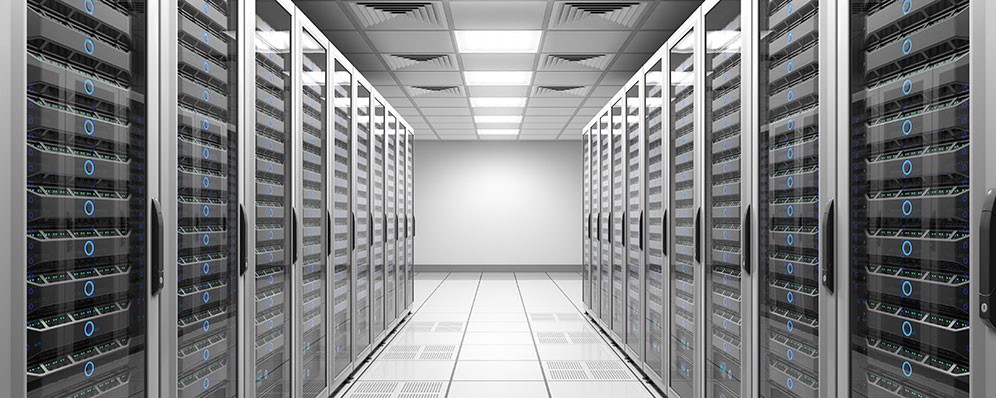
Cloud computing has taken the IT industry by storm and along with it has come mass confusion. I can’t tell you how many recent cloud conversations I have had with seasoned IT professionals where they incorrectly referenced the cloud. I hope this blog will help you, as it has others, by providing a simple non-technical cloud definition and explanation of the three most important cloud terms: SaaS, PaaS, and IaaS.
Traditional Data Center-Centric Computing Model
An understanding of the cloud begins with a reference to the traditional enterprise computing model. Since the birth of corporate computing, organizations would buy computer hardware and either build or buy software applications to run on that hardware. The hardware and software would be managed in either an on-site or offsite corporate data center like the one pictured below. This model required an upfront capital investment of a physical facility (or rental of someone else’s facility) with appropriate air conditioning, internet connectivity, security, etc. Additionally, there was an upfront investment in hardware based on current needs and expected future demand.
Cloud Definition
With increasing internet speed and constant availability of new technology, the Cloud emerged as an alternative to the traditional data center model. In its simplest terms, the cloud is the on-demand usage of someone else’s computer resources. In other words, you are paying for the service rental of a vendor’s data center and potentially software. Hence the reason that many cloud terms are post scripted with “as a Service or aaS”.
The easiest way to understand the cloud concept is to draw an analogy to outsourced payroll services. With a payroll provider, you are paying a monthly fee. You can customize the mix of services, expand or contract the services based on your ever-changing employee base, and pay for the service as you use it. The same is true with the cloud. You can buy many different types of cloud services, pay for them on a monthly basis and expand or contract usage as your business needs change.
Cloud Services
Cloud services are typically categorized as either Software as a Service (SaaS), Platform as a Service (PaaS) or Infrastructure as a Service (IaaS).

Organizations can mix and match these services depending on their needs. For example, they may use SaaS for their sales application and IaaS for their finance application. The following sections describe each of the cloud categories or layers.
Software as a Service (SaaS)
Software as a Service (SaaS) is the highest layer of the cloud and typically the easiest to understand because most people already use it either in their personal or professional life.
In a SaaS model, you pay a monthly subscription fee to use a vendor’s software to perform business processes. Unlike traditional on-premise software, the software runs in the vendor’s data center. Thus, your organization does not need to install the software or have any associated hardware. All that is typically needed is a browser to access the software via the internet.
Oracle dominates the SaaS market with a large portfolio of SaaS software. Examples include Customer Relationship Management, Human Capital Management, and Enterprise Resource Planning (Click here to learn about Oracle’s SaaS applications).
Companies are shifting to SaaS software for many reasons. Users enjoy the modern user interfaces, mobile access, and integrated features. CIO’s like that they can reallocate IT resources from data center management to higher value-added activities. And, CFO’s like SaaS software as they are freed from the capital-intensive requirements of traditional software and the associated data center infrastructure.
However, not every company is jumping on the SaaS bandwagon just yet. Immaturity of features, cost of a new implementation and other business priorities might be in the way (See Are Your Ready for Cloud ERP for further insights about SaaS considerations).
Infrastructure as a Service (IaaS)
Infrastructure as a Service (IaaS) is the lowest layer of the cloud and the next easiest category to understand. It is a service where you pay to use just the raw hardware, networking, and storage capabilities to run any type of workload. Like SaaS, you pay a monthly usage fee. However, with IaaS, there isn’t any software. You have to develop or install your own.
Companies use the IaaS when they no longer want to run their existing software in their data center. Much like moving software from one data center to another, they simply ‘lift and shift’ the software to the IaaS layer of the cloud and in turn, shut down their data center resources.
The primary benefit of moving an application to the IaaS cloud layer is that you can get more life from an existing software investment while reducing infrastructure costs and increasing infrastructure flexibility for future growth (See Cloud Alternatives to SaaS ERP for a more comprehensive list of benefits). Again, Oracle is a dominant player in the IaaS marketplace. Click here to learn more about Oracle’s IaaS offering.
Platform as a Service (PaaS)
Platform as a Service (PaaS) is the middle layer of the cloud. The best way to understand PaaS is to think about it as a building block on top of IaaS for custom application development and deployment. With PaaS, you get the computer, network, and storage of IaaS plus additional tools for specific for application development. For example, in the Oracle World, you get tools such as Java as a Service (JaaS) and Database as a Service (DBaaS) in addition to embedded capabilities such as business intelligence and mobile. Click here to learn more about Oracle’s PaaS offerings.
Companies use PaaS simply because it is fast and easy when developing new applications. No longer do they have to wait weeks and sometimes months for hardware procurement, machine setup and tool installation to start building applications. You simply go online, request an environment and start developing. And, by the way, you are always assured the tools releases.
Summary
A recent IDC survey recently reported 67% of respondents already use the cloud and 78% of respondents have firm plans to use the cloud. Your organization’s ability to understand the cloud and determine a strategy will be critical to increasing IT productivity, reducing IT costs, increasing agility and reducing time to market.
The diagram below is a ‘cheat sheet’ that summaries the content of this blog. Keep it handy for the next time someone brings up the cloud. And, be sure to ask them, are you referring to SaaS, PaaS, and IaaS;) I guarantee it will lead to a better conversation.

Contact one of our consultants to see where the cloud fits in with your strategy.
